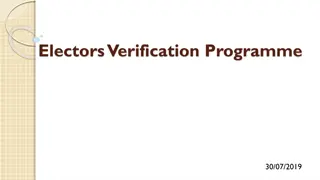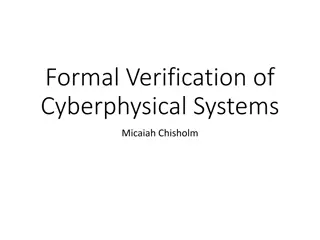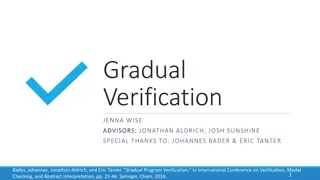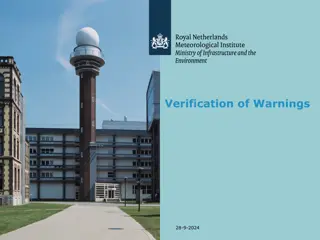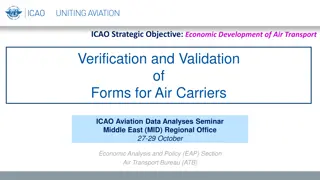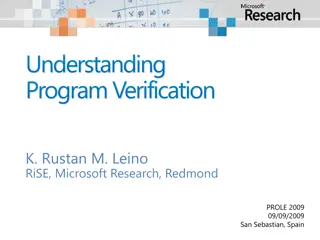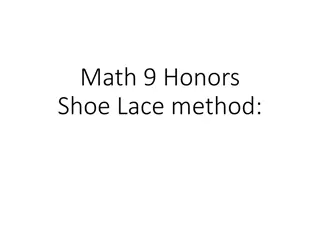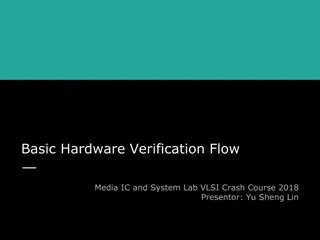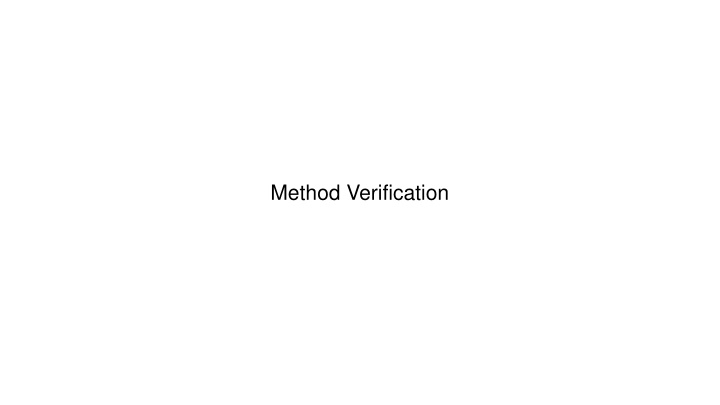
Analytical Method Verification and Calibration: Importance and Procedures
"Learn about method verification, calibration, and assessment in analytical testing to ensure accurate measurement results for customers. Explore calibration processes, trueness, accuracy, and common issues like the Hook Effect in Immunoassay techniques."
Download Presentation

Please find below an Image/Link to download the presentation.
The content on the website is provided AS IS for your information and personal use only. It may not be sold, licensed, or shared on other websites without obtaining consent from the author. If you encounter any issues during the download, it is possible that the publisher has removed the file from their server.
You are allowed to download the files provided on this website for personal or commercial use, subject to the condition that they are used lawfully. All files are the property of their respective owners.
The content on the website is provided AS IS for your information and personal use only. It may not be sold, licensed, or shared on other websites without obtaining consent from the author.
E N D
Presentation Transcript
Introduction An assessment focusing on how the analytical test procedure is suitable for its intended use under actual experimental condition It is important in ensuring that measurement results reported to customers are correct
It is done by 1. Calibration 2. Trueness/Accuracy 3. Precision 4. Linearity 5. Limit of detection 6. Limit of Quantification 7. Specificity
Calibration Calibration is the process of configuring an instrument to provide a result for a sample within an acceptable range Nothing but relationship B/W the Instrument (Y) and measurement of Analyte (X) Y=f(X) Relationship is established by measurement of sample with known quantities of analyte
Calibration function may be linear or curved in case of Immunoassay it may take special form logistic in log x used in Immunoassay techniques and written in several forms. Alternative model free approach is used to estimate smoothed spline curve often performed for Immunoassay DISADVANTAGE: insensitive to aberrant calibration values
If assumed calibration function does not reflect the true relationship a systematic error is associated with analytical method. Common problem in Immunoassay is Hook Effect i.e deviated from expected calibration algorithm in high concentration range If calibration function is linear and imprecision of signal response is same over the analytical measurement range. Imprecision value increase the proportionally to the signal response then the analytical SD of the methods tends to increase proportionally to concentration
Trueness Closeness of agreement B/W the average value obtained from large series of results of measurements and true value Difference B/W average value and true value is bias and expressed numerically inversely related to trueness Expressed as Low, Medium, High ISO- introduced trueness expression as the replacement for the term accuracy
Accuracy Closeness agreement B/W the result of measurement and true concentration of analyte and it is influenced by both Bias and imprecision this reflects total error In relation to trueness, the concept 1. Recovery 2. Drift 3. carryover
Recovery Fraction by % increase in concentration measured in relation to the amount added Carried out in the field of drug analysis Recovery close to 100% is pre-requisite for high degree trueness
Drift Caused by the instrument or reagent instability over time so that calibration is biased
Carryover Assay must be close to ensure unbiased results i.e placing the sample with known low value after a pathological sample with high value and observe Increase can be stated as % of high value
Precision Closeness of agreement B/W independent results of measurements obtained under stipulated conditions Degree of precision expressed on the bias of statistical measures of imprecision SD/CV=SD/x Imprecision solely related to randam error of measurement 1. Repeatability 2. Reproducibility
Repeatability Closeness of agreement B/W results of successive measurement carried out under the same condition
Reproducibility Closeness of agreement B/W results of measurement performed under changed condition of measurement Two specifications often used 1. Total / B/W run precision intermediate precision 2. Interlab precision
Total SD 1. Within run components 2. Between run components
Precision profile Depends on the concentration of analyte being considered Plotted in terms of SD or CV as a function of analyte concentration
Linearity Relationship B/W measurement and expected values over the analytical measurement range Relative analyte concentration dilution sample may be used Dilution carried out with appropriate sample matrix/ verified sample diluent Evaluation conducted in various ways More formal carried out on the bias of statistics
Analytical measurement range Analyte concentration, range over which measurements are within the declared tolerance for imprecision and bias of the method Measurement of range extend from LLOQ to ULOQ for which performance specification are fulfilled
Limit of detection Characteristics of an assay defined as lowest value that significantly exceeds the measurement of a blank sample Limit detected/estimated on the basis of repeated measurements of blank sample reported as mean +2SD., +3SD
Analytical sensitivity LLOQ not confused with analytical sensitivity Ability of an analytical method to assess small difference in concentration of analyte
Analytical specificity Ability of an assay procedure to determine the concentration of target analyte without influence / factor



